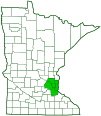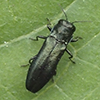bluish borer
(Agrilus cyanescens)
Conservation • Description • Habitat • Ecology • Distribution • Taxonomy
Conservation Status |
|
|||||||
| IUCN Red List | not listed |
|||||||
| NatureServe | NNR - Unranked |
|||||||
| Minnesota | not listed |
|||||||
Description |
||
Bluish borer is an exotic, robust, small, wood-boring beetle. It is native to Europe and northern Asia. The first sightings in North America occurred in 1920 in Sturgeon Bay, Wisconsin, and in 1921 in Sherborn, Massachusetts. At both sightings they were reported as abundant. The beetle now occurs in the United States from Maine to virginia, west to Minnesota and Missouri, in western Washington and Oregon, in southern Canada from New Brunswick to Manitoba, and in western British Columbia. It is uncommon in Minnesota, where it reaches the western extent of its range. Larvae hosts include honeysuckle (Lonicera spp.), snowberry (Symphoricarpos spp.), and buckthorn (Rhamnus spp.). The larvae bore under the bark and feed on the sapwood of living branches and twigs, eventually causing these parts to die. However, the beetle does not occur in large enough numbers to be considered a pest of significant concern. Adults are 3⁄16″ to 5⁄16″ (5.2 to 7.8 mm) in length. The body is rigid, bullet-shaped, narrow, and long. The upper side is hairless, metallic, slightly shiny, and uniformly blue, bluish-green, bluish-violet, or rarely bronze. The head is slightly tucked beneath the first segment of the thorax (prothorax). The antennae are short and have 11 segments. Segments 4 through 11 are sawtoothed. Segments 7 to 11 are as long as wide. The mouthparts are projected downward. The upper plate covering the prothorax (pronotum) is wider than long, is narrowed in the middle, and has a distinct lateral margin. The lateral margin is rounded. There is no ridge on each side near the rear corners, and there is no longitudinal depression down the middle. The plate between the wing bases (scutellum) is small but visible. It is not crossed with ridges. The abdomen has five segments. The first two segments are fused together. They are barely visible or not at all visible at the sides. The wing covers (elytra) are slightly narrowed before the middle and tapered beyond the middle toward the tips. They almost cover the entire abdomen. Toward the tip the inner margins are slightly elevated. The tips are separated and rounded. The surface is sculpted like shingles on a roof. The last segment of the abdomen does not have a distinct ridge above. The last part of the leg (tarsus), corresponding to the foot, has 5 segments. There is a pair of claws at the tip of each tarsus. |
||
Size |
||
Total length: 3 ⁄16″ to 5 ⁄16″ (5.2 to 7.8 mm) |
||
Similar Species |
||
Habitat and Hosts |
||
Honeysuckle (Lonicera spp.), snowberry (Symphoricarpos spp.), and buckthorn (Rhamnus spp.) |
||
Ecology |
||
Season |
||
May to July |
||
Behavior |
||
Adults are good fliers. |
||
Life Cycle |
||
|
||
Larva Food |
||
Sapwood in the twigs and branches of host species |
||
Adult Food |
||
Leaves of the same plants as the larvae |
||
Distribution |
||||
|
Sources |
|||
| 11/21/2022 | ||||
Occurrence |
||||
|
||||
Taxonomy |
|||
Order |
Coleoptera (Beetles) | ||
Suborder |
Polyphaga (Water, Rove, Scarab, Long-horned, Leaf, and Snout Beetles) | ||
Infraorder |
Elateriformia | ||
Superfamily |
Buprestoidea | ||
Family |
Buprestidae (jewel beetles) | ||
Subfamily |
Agrilinae | ||
Tribe |
Agrilini | ||
| Subtribe | Agrilina | ||
Genus |
Agrilus | ||
Subgenus |
|||
Subordinate Taxa |
|||
bluish borer (Agrilus cyanescens cyanescens) bluish borer (Agrilus cyanescens johanidesi) |
|||
Synonyms |
|||
Agrilus amabilis Agrilus caeruleus Agrilus cyaneus Agrilus fissifrons Agrilus kyselyi Agrilus sulcaticeps Agrilus virens |
|||
Common Names |
|||
bluish borer |
|||
Glossary
Elytra
The hardened or leathery forewings of beetles used to protect the fragile hindwings, which are used for flying. Singular: elytron.
Pronotum
The exoskeletal plate on the upper side of the first segment of the thorax of an insect.
Prothorax
The first (forward) segment of the thorax on an insect, bearing the first pair of legs but not wings.
Scutellum
The exoskeletal plate covering the rearward (posterior) part of the middle segment of the thorax in some insects. In Coleoptera, Hemiptera, and Homoptera, the dorsal, often triangular plate behind the pronotum and between the bases of the front wings. In Diptera, the exoskeletal plate between the abdomen and the thorax.
visitor Photos |
|||||
Share your photo of this insect. |
|||||
| This button not working for you? Simply email us at info@MinnesotaSeasons.com. Attach one or more photos and, if you like, a caption. |
|||||
Babette Kis |
|||||
Agrilus cyanescens bluish wood boring beetle Agrilus cyanescens, bluish borer, at the hedgerow at Barnes Prairie, Racine Co., WI. Photo taken May 31, 2021. |
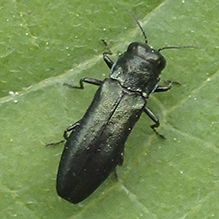 |
||||
Alfredo Colon |
|||||
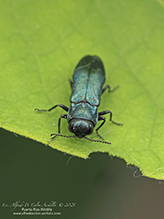 |
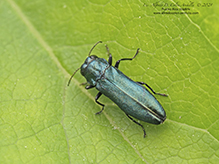 |
||||
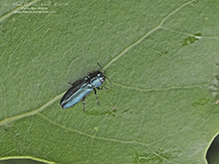 |
|||||
MinnesotaSeasons.com Photos |
|||||
|
|||||

Slideshows |
||

visitor videos |
|||
Share your video of this insect. |
|||
| This button not working for you? Simply email us at info@MinnesotaSeasons.com. Attach a video, a YouTube link, or a cloud storage link. |
|||
Other videos |
|||
| Metallic Wood-boring Beetle (Buprestidae: Agrilus cyanescens) Carl Barrentine |
|||
About
Jun 12, 2011 Photographed at the Turtle River State Park, North Dakota (08 June 2011). Thank you to 'v belov' and T.C. MacRae (@Bugguide.net) for confirming the identity of this specimen! |
|||


Created: 11/21/2022
Last Updated:
